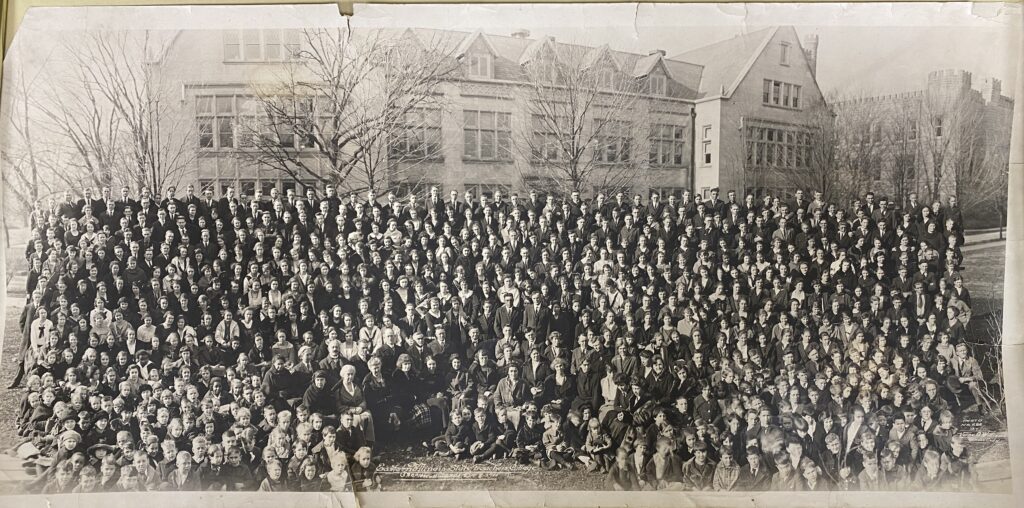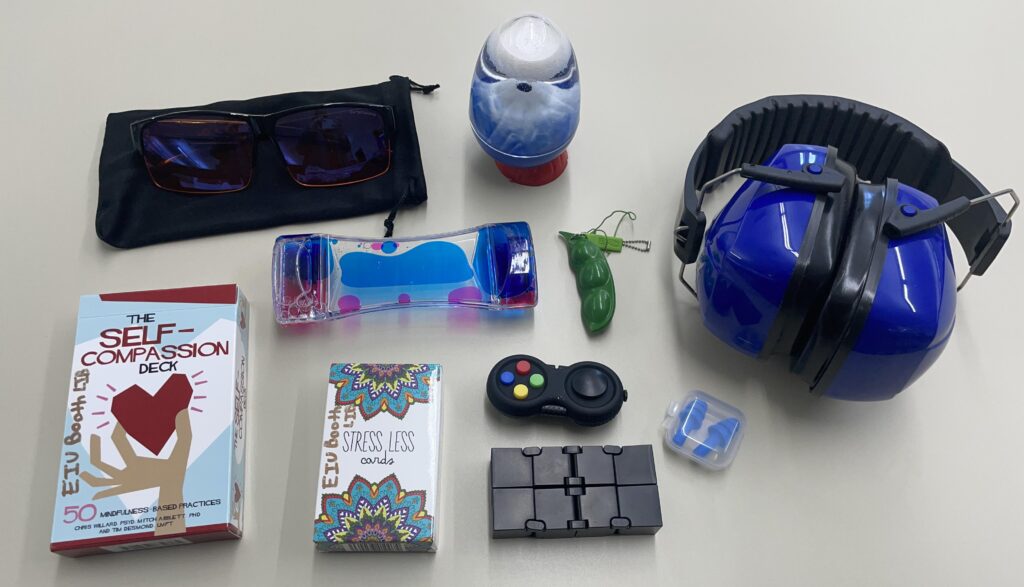Library News
‘A picture is worth a thousand words’
Posted on March 24th, 2023

By Madeline Steiner
University Archives Intern
Among the University Archives at Booth Library are numerous collections of historical documents, objects, and photos – items that carry so much historical information and significance. One such collection is that of Eastern’s all-class photographs, “all-class” meaning everyone involved in the school, including professors, students freshman through senior, and, in most cases, the lab school students, as well.
Today, it sounds like a pretty daunting task just to get one whole class into the same photo, let alone the entire school; however, the collection is a small one, including six panoramic photographs from the late 1910s into the early 1920s, when the class sizes were much smaller. Eastern opened its doors to students on Sept. 12, 1899, with a starting faculty of 18 and with around 125 students. As the years went on, the numbers grew and were up to around 450 in the 1919 school year and in 1924, students, faculty, and lab school students made equaled about 600, which was still rather manageable for a photograph.
Item #1 in the collection is not dated but is from around the late 1910s into the early 1920s, notable by the fact that the school is still titled Eastern Illinois State Normal School, which was Eastern’s name upon being approved in 1895. The name then changed in 1921 to Eastern Illinois State Teachers College. This change can be noted through the timeline created by the photos.
Item #4 was taken March 31, 1921, near the end of the school’s time as Eastern Illinois State Normal School. Item #3 was taken Dec. 8, 1921, and is titled Eastern Illinois State Teachers College. The name change was made between March and December in 1921. Item #4 is also not dated on the physical photograph but can be found in the school’s 1921 edition of the Warbler (they used to print fairly detailed schedules of the entire year in the Warbler), which also includes numerous photos of classes, faculty, and campus.
Of the six photographs, five were taken by Kansas City, Missouri photographer Verne O. Williams, who was evidently well-versed in panoramic photographs. His 1917 Camp Funston series is proof of this. The seven panoramic style photos document the year of construction on Fort Riley’s Camp Funston in Kansas, including construction progress of the entire camp, staff members, and even the crowds of the 1917 football game against the University of Illinois.

The panoramic photo was quick to be experimented with upon the invention of the camera in 1839. Early panoramas were produced by placing two or more daguerreotype panels (the first commercialized photographic process) next to each other and they began appearing as early as 1851. Because of the desire for panoramic photos, in the late 19th century, cameras were mass produced specifically for panoramas.
The first mass-produced American panoramic camera was in 1898. These mass-produced cameras were easy to develop but could only create small panoramas that could be no longer than 12 inches and only had a field of vision of about 180 degrees, so, in 1904, the Cirkut Camera was patented. This panoramic camera was capable of producing a 360 degree photograph measuring up to 20 feet long. We can infer from the Eastern Illinois prints that Williams might have used a Cirkut Camera because these cameras were commonly used for group photographs and landscapes. Plus, every photo in the collection is well over 12 inches long, with the shortest in length being 32 inches and the longest at 46 inches.
Studying these photos could easily lead the researcher down a rabbit hole of information about Eastern’s past. For example, most of us probably know that Pemberton is one of the oldest buildings on campus, but the greenhouse seen in one of the collection’s photos was the second oldest structure, next to Old Main. Built in 1902, it was designed to provide decorative greenery for the main building. This greenhouse can be seen in the oldest of the collection’s photos, which was taken behind Old Main, in just about the middle of what would be the North Quad today.
Pemberton, only barely noticeable in the same photo, was the third building approved in 1907 and named after Senator and Eastern supporter Stanton C. Pemberton in 1909. Built as an all-female dorm, it was Illinois’s first college dormitory built for the purpose of creating a real campus community. Lord “wanted it to be more than a boarding house; he wanted to provide a family atmosphere for the students” (Otta, 58). Because it was the first of its kind in Illinois, it took a lot of work on the part of President Lord and Senator Pemberton, but it was finally approved, along with a “cracker box” gymnasium, in 1907 and was formally opened in January of 1909.
Blair Hall, seen behind students and faculty in photograph #3, was the fourth building on campus. Blair, originally named the Training School Building, was built for the purpose of training future teachers through the Model School, which was moved there upon the building’s completion in 1913. Later it was referred to as the “lab” school, and was attended by the children of Charleston as well as university faculty. The Training School Building was renamed Blair Hall in 1958.
The details of history can be found anywhere if you look hard enough and do the research. The 1920s all-class photo collection is just one example of many that packs so much information into a few images.
Madeline Steiner is a senior majoring in English from Lincoln, Illinois.
Works Cited
“Barnhart, Terry. “That ‘Noble Project:’ The Founding of Eastern Illinois University and the Origins of Old Main, 1895-1899.” Eastern Illinois University, https://www.eiu.edu/localite/oldmainnobleproject.php. Accessed 24 Feb. 2023.
“A Brief History of Panoramic Photography.” Library of Congress, https://www.loc.gov/collections/panoramic-photographs/articles-and-essays/a-brief-history-of-panoramic-photography/. Accessed 3 Mar. 2023.
Eastern Illinois University, “1918-1968 Warbler: ‘On the Road to Somewhere,’” 1968. The Warbler, 2. http://thekeep.eiu.edu/warbler/2.
Otta Sherri, “Still Going Strong,” 1990. The Warbler, 63, p58-59. http://thekeep.eiu.edu/warbler/6.
Williams, Verne O. and Charles A. Stead. Camp Funston, Fort Riley, Kansas. 25 Jul. 1917, Kansas Historical Society, https://www.kshs.org/archives/218831.
—. Camp Funston, Fort Riley, Kansas. 29 Aug. 1917, Kansas Historical Society, https://www.kshs.org/archives/218834.
—. Camp Funston, Fort Riley, Kansas. 19 Sep. 1917, Kansas Historical Society, https://www.kshs.org/archives/218840.
—. Camp Funston, 14th National Army Cantonment, Fort Riley, Kansas. 1917, Kansas Historical Society, https://www.kshs.org/archives/226933.
—. Engineers, Sanitary Train, Fort Riley, Kansas. 28 Sep. 1917, Kansas Historical Society, https://www.kshs.org/archives/226891.
—. Field Auditor’s Staff, 14th National Cantonment, Camp Funston, Fort Riley, Kansas. 3 Oct. 1917, Kansas Historical Society, https://www.kshs.org/archives/226887.
—. Football Crowd at Camp Funston, Fort Riley, Kansas, Thanksgiving Day. 29 Nov. 1917, Kansas Historical Society, https://www.kshs.org/archives/226921.
Study success kits available on 4th floor
Posted on March 3rd, 2023
A study session goes much better when you are relaxed, focused, and feeling good about yourself. Booth Study Success kits have items to help students get in the right frame of mind to do their best work.
Affirmation cards give you scripts for positive self-talk. Fidget toys can help burn off anxious energy. Timers offer a soothing visual experience and a way to time a break in your study session.

Do fluorescent lights or screen glare leave you feeling overwhelmed? Block the blue light wavelength with the blue-blocking glasses in the kit. If it’s the noise rather than the light that is a distraction, we also offer ear muffs, ear plugs, and a white noise machine.
Feeling ungrounded and floaty? Borrow the weighted blanket for some calming coziness.
All items are available at the Library Technology Services counter on the fourth floor. Kits are available for checkout for one day. The earmuffs, sound machine and blanket must be used in the library. The ear plugs are yours to keep.



